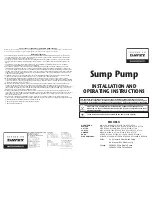
www.gdts.one
451903.66.07 · FD 9908
EN-7
BWP 20A
English
Notes on economical use of energy:
To achieve a high COP with the integrated heat pump whilst
cutting water level losses, the hot water heat pump should
not be operated at a hot-water temperature above 45°C (see
illustration).
Only set the temperature controller to higher values or man-
ually switch on the heating element if necessary.
To ensure optimum compressor operating times and down-
times, it is important to avoid manual and repeated switching
on and off of the heat pump!
“Heat Pump – Ventilation” switch
The heat pump is ready for operation when the “Heat Pump”
switch is in the “ ” position. If the hot-water temperature in the
cylinder drops below the set value, the heat pump will be acti-
vated until the desired hot-water temperature has been reached.
In the "I" position, the heat pump is in stand-by and goes into op-
eration as soon as the request for hot water preparation is recog-
nised. When no request for hot water preparation exists, the heat
pump operates in ventilation operation (ventilator is permanently
active).
“Heating Element” switch
If more hot water is needed or if a higher water temperature
(> 60 °C) is desired, the “Heating Element” switch can be used to
switch on the integrated 1.5 kW radiator.
If the “Heating Element” switch is in the “I” position, the approx.
upper third of the cylinder will be heated up to the maximum tem-
perature of the heating element controller (factory setting 65 °C);
at hot-water temperatures > 60 °C, DHW preparation is done by
heating element only.
Note
Heating element controller
The heating element controller is a second control unit for the op-
erating range of the electric heating element, and independent of
the hot-water controller. The factory set switch-off temperature of
65 °C can be changed by a technician (see cap. 2.3 on page 3)
7 Maintenance
ATTENTION!
!!
Disconnect the power supply before opening the hot-water heat pump;
observe possible coasting of ventilator.
General information
The hot water heat pump is virtually maintenance-free. A one-off
visual inspection for possible leakage in the water system or
stopping-up of the condensate outflow should take place a few
days after the maintenance work has been carried out.
Do not carry out any maintenance work on the refrigerating cir-
cuit of the heat pump.
Only use a damp cloth and soap solution for cleaning the hot-
water heat pump.
ATTENTION!
!!
Ensure water does not come into contact with the operator controls.
Unplug mains plug/disconnect the power supply before beginning any
cleaning work.
7.1 Water Circuit / Condensate
Outflow
The water circuit check is limited to filters that may have been in-
stalled on-site, and possible leakage. Dirty water filters should be
cleaned and replaced if necessary. Occasionally check the seal
valve in the condensed water hose for contamination; replace if
necessary.
7.2 Air Circuit
Maintenance work is limited to cleaning the evaporator on a reg-
ular basis, and as needed.
ATTENTION!
!!
Risk of injury caused by sharp-edged fins. Fins must not be deformed or
damaged!
If air filters are used, they should be regularly checked for con-
tamination and cleaned and replaced if necessary.
7.3 Corrosion Protection Anode
The corrosion protection anode installed in the hot water cylinder
should be electrically checked on a regular basis, at least every
two years after start-up, and be replaced if necessary. Electrical
checking is carried out by means of a suitable ammeter, without
draining the tank.
(Corrosion protection anode position - see the dimension dra-
wing in the Appendix).
Procedure:
1)
Unplug PE cable from protection anode tab.
2)
Connect ammeter (0...50mA) between PE cable and tab.
3)
Evaluation of protection anode wear:
Measured value > 1 mA
protection anode is in working
order.
Measured value < 1 mA
protection anode must be tested
or replaced.
If electrical testing does not provide any clear results, a visual in-
spection of the protection anode by a technician is recom-
mended.
Should replacement of the protection anode [by a technician] be
necessary, the tank must be drained via the valve provided (fitted
during installation - see Appendix).
ATTENTION!
!!
Malfunctioning protection anodes reduce the operating life of the device!
(Reactive anode: electrically insulated magnesium anode with selenium
according to DIN 4753 Part 6)
Summary of Contents for BWP 20A
Page 2: ......
Page 14: ...DE 12 451903 66 07 FD 9908 www gdts one Deutsch BWP 20A...
Page 24: ...EN 10 451903 66 07 FD 9908 www gdts one English BWP 20A...
Page 34: ...FR 10 451903 66 07 FD 9908 www gdts one Fran ais BWP 20A...
Page 41: ...www gdts one 451903 66 07 FD 9908 A VII BWP 20A Anhang Appendix Annexes...
Page 42: ...A VIII 451903 66 07 FD 9908 www gdts one Anhang Appendix Annexes BWP 20A...
Page 43: ...www gdts one 451903 66 07 FD 9908 A IX BWP 20A Anhang Appendix Annexes...
















































